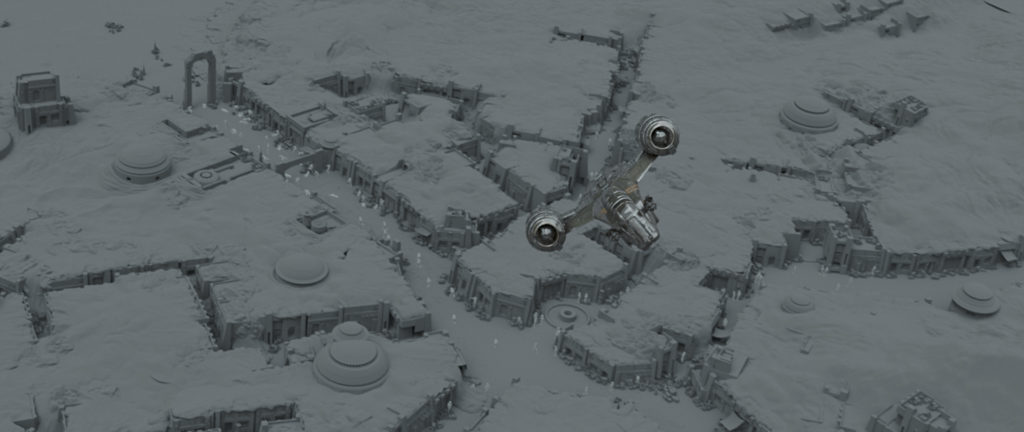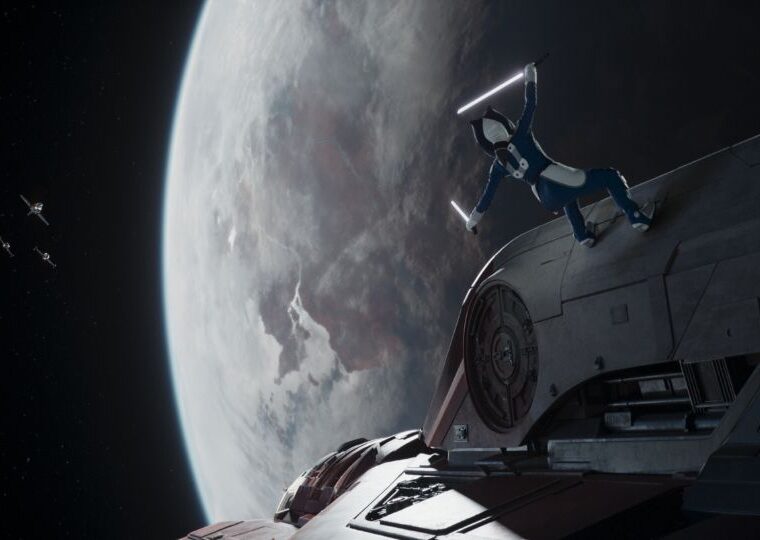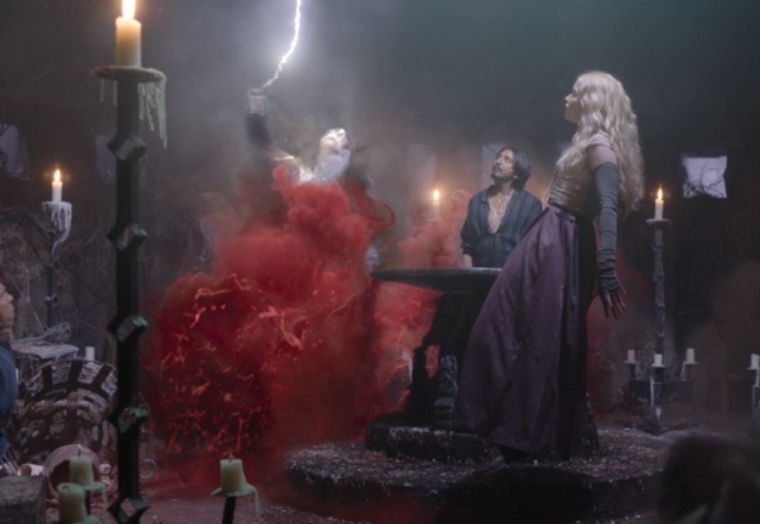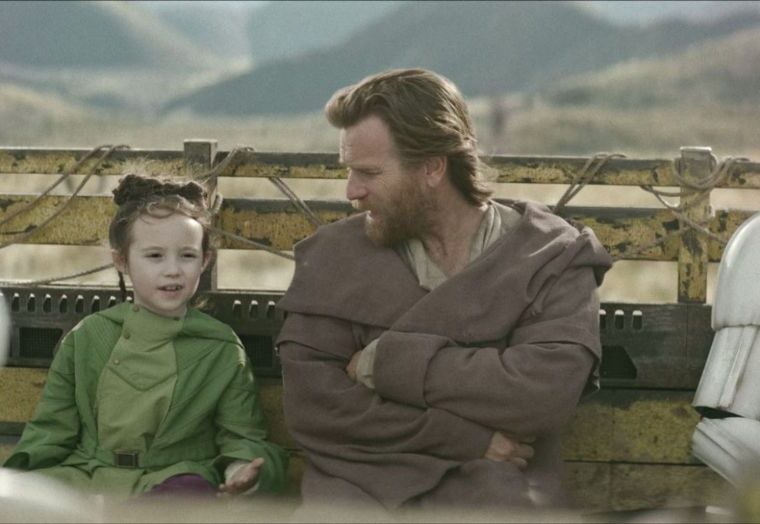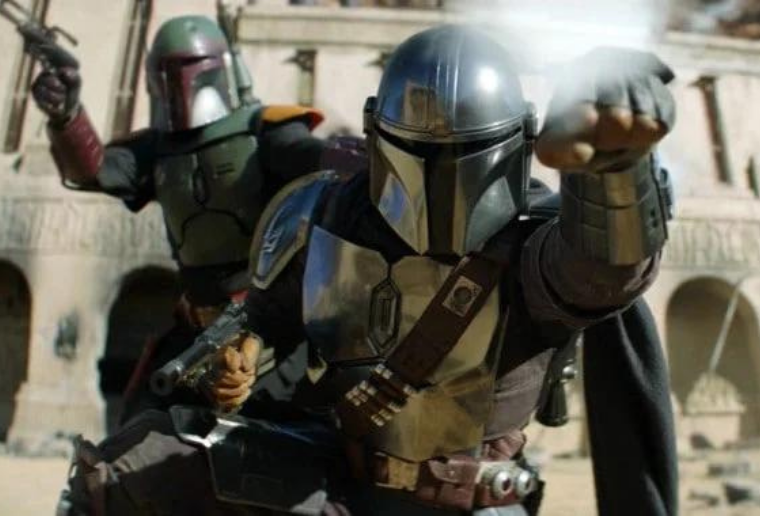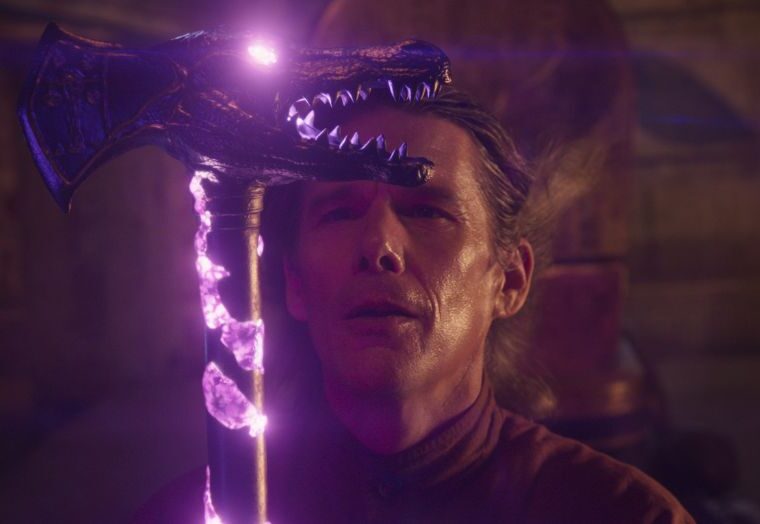The Mandalorian: Season 1 Case Study
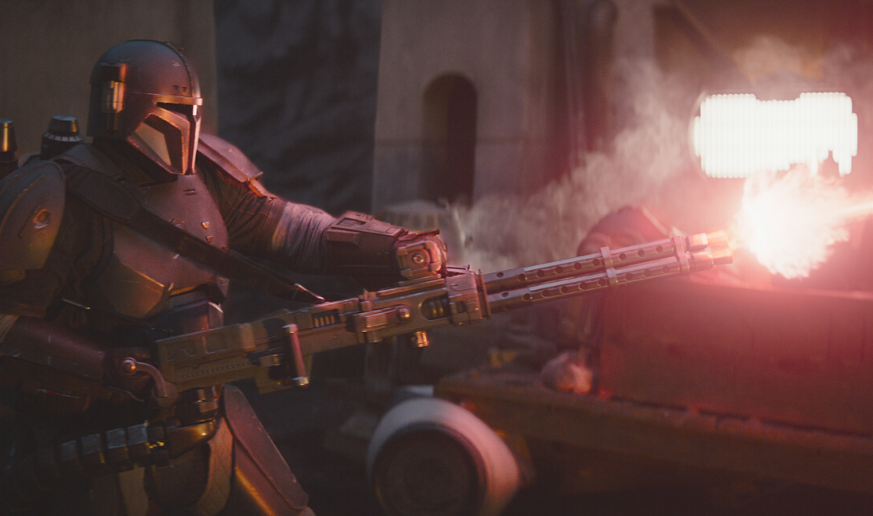
Case Study
The Mandalorian took the audience through the experiences of a lone gun-for-hire as he seeks to earn his living. Image Engine went along for the ride, handling 441 shots that tell the tale of this bounty hunter and the people from whom he hails.
With his cold demeanor and inscrutable T-shaped visor, Boba Fett achieved cult status among Star Wars’ legions of fans. Nevertheless, the backstory of his people received little more than lip service; Fett wore the armour of Mandalore, but the story of his heritage went only skin deep. Disney+ launch show (and the first-ever live-action Star Wars television series) The Mandalorian sets out to remedy this. It takes audiences further below the surface of Mandalorian martial culture via the experiences of one lone gun-for-hire as he seeks to earn his living. Image Engine went along for the ride, handling 441 shots that tell the tale of this bounty hunter and the people from whom he hails.
The Mandalorian takes place in a galaxy bereft of order. The Rebels have destroyed the Death Star MK. 2, the Empire has fallen, and the embers of the celebratory Ewok fires have long since died down. And yet, with no dictatorship to impose its will, society has collapsed like a dying sun. Into the shadows crawl all sorts of villainy and scum – and those that seek to stop them.
Taking place after The Return of the Jedi and before The Force Awakens, The Mandalorian shows us a new Star Wars galaxy; one where crime is rife and violence a commodity. It’s a lawless world with all the moral solvency of a Spaghetti Western. And it’s against this backdrop that our Mandalorian – “Django Fett”, if you will – sets out on a new and brutal adventure.
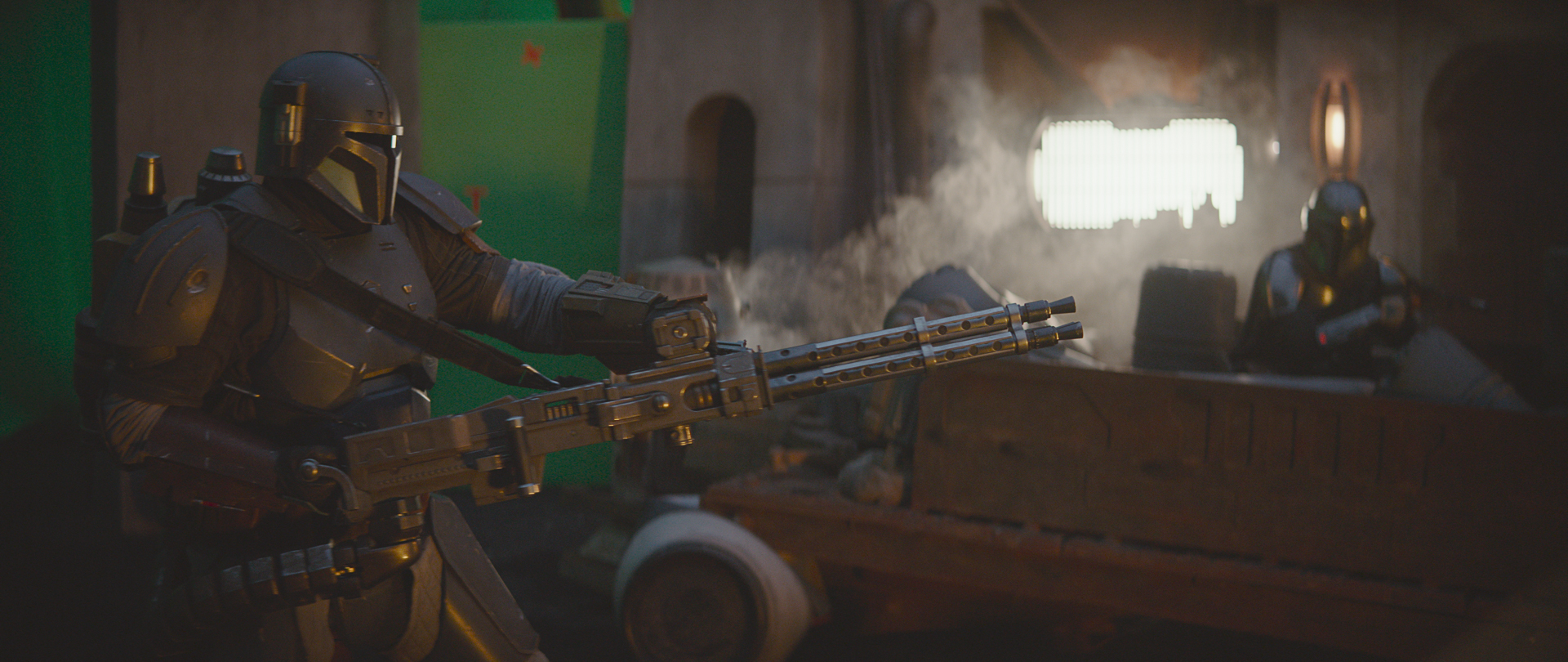

Image Engine swung through the saloon doors to take on 441 shots across this story, from animating droids to building bounty hunter battles on far-flung worlds.
“For a television schedule, it was a substantial amount of work,” says Cara Davies, VFX producer. “Nevertheless, we wanted to do justice to the universe that Lucasfilm built over the past four decades. We wanted to bring the kind of eye-opening sequences fans have come to expect from big-screen Star Wars to the smaller screens at home.”
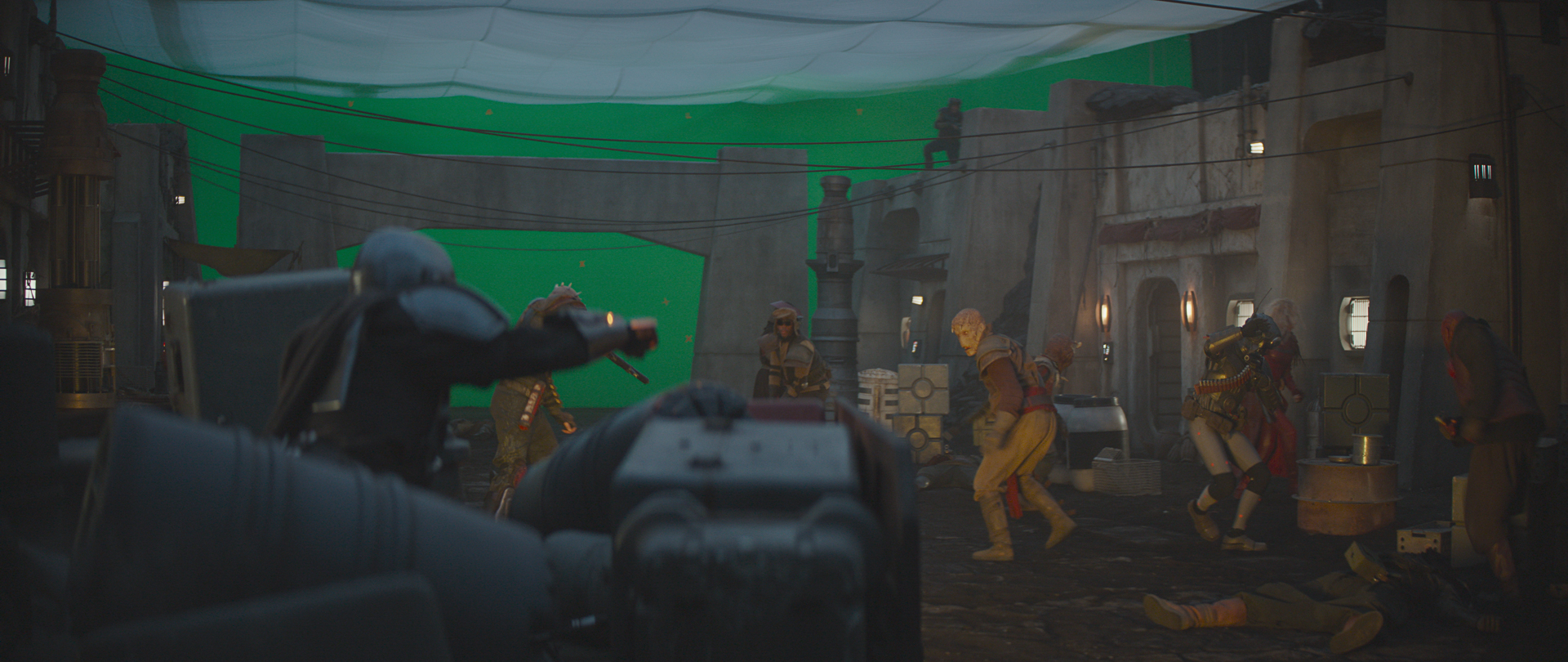

Image Engine split its body of work into three separate groups, treating each with the care and attention afforded to independent projects. Each group had its own compositing leads and CG supervisors, and Shane Davidson and Robin Hackl ensured cohesion as overall compositing and VFX supervisor, respectively.
From there, the studio rolled up its sleeves, loaded its laser blaster, and jet-packed into action.
Showdown on Nevarro
Like a reverberating gunshot, Image Engine’s Nevarro sequence most echoes the hard-edged adventure of Sergio Leone’s filmmaking. It’s all guns, grit and laser blasts, as the Mandalorian attempts to rescue a package from a volcanic planet, while waylaid by thugs, mercenaries, and Carl Weather’s villainous Greef.
Nevarro’s core action was shot on a soundstage populated with various practical elements. “We extended everything beyond that set,” says Hackl. “That meant full-CG environments – one looking back into the city, and another into a landing bay with ships coming into land. We built that entire backdrop.”

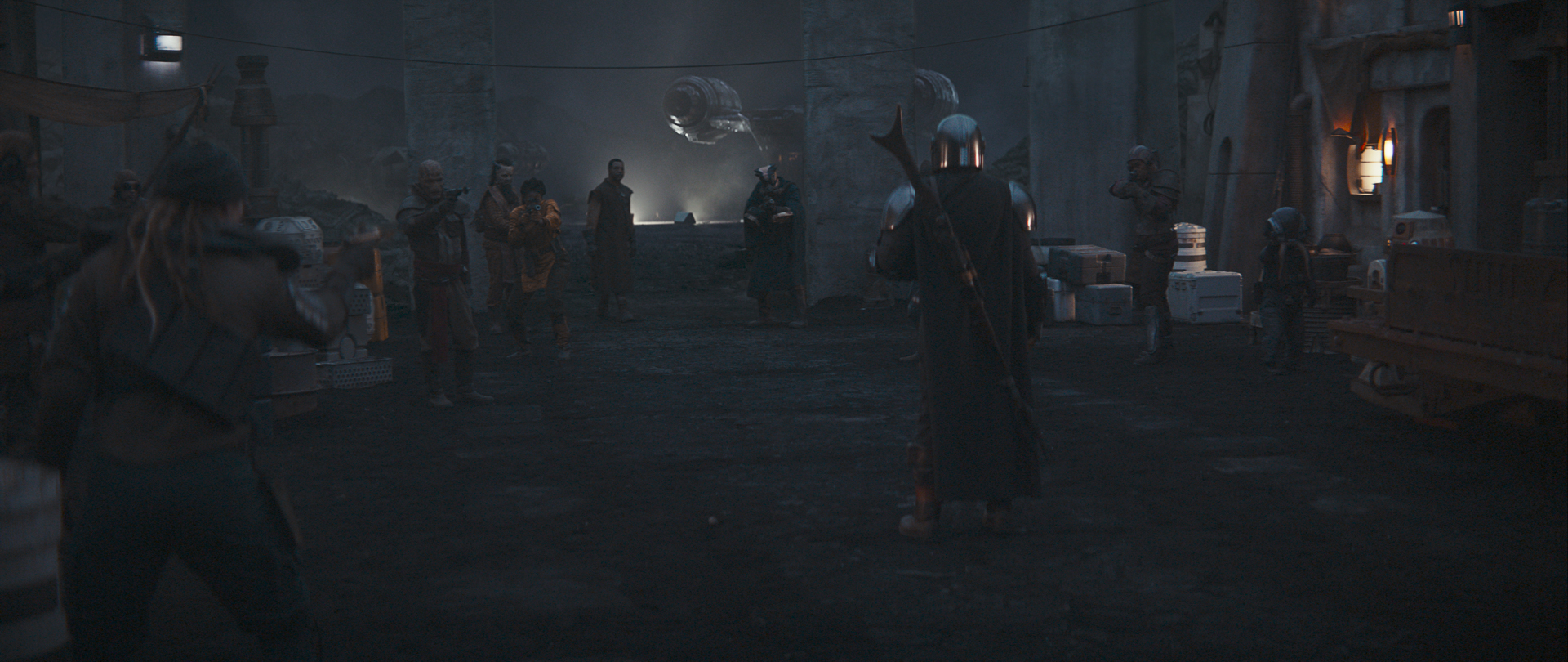
The team also animated the digi-double Mandalorian and designed/animated several of his cohorts. “These Mandalorians don’t have a ‘uniform’ – they’re continually finding, updating and replacing parts,” says Barry Poon, Asset Supervisor. “Nothing is matching. It’s worn and ragged. We added a lot of variety and discolouration to each armour set to ensure that none of the characters felt as if they repeated.”
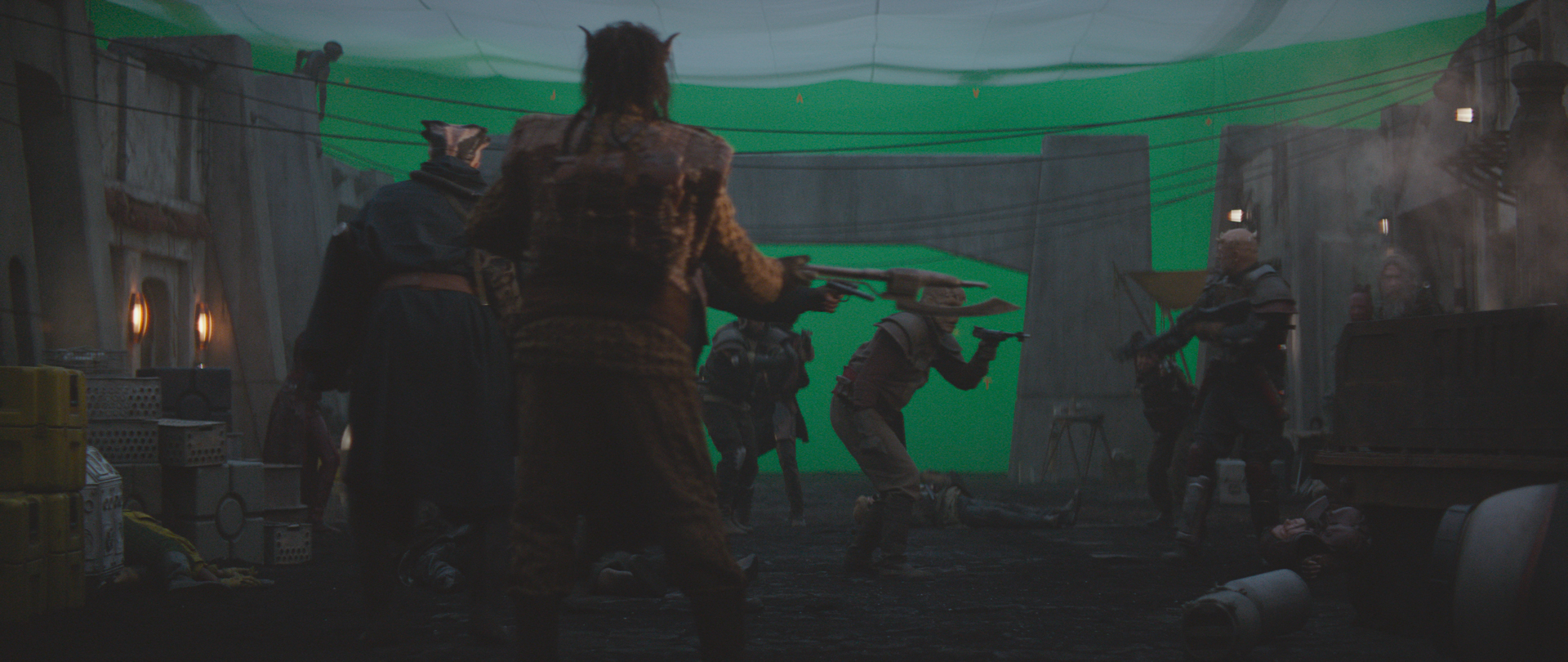

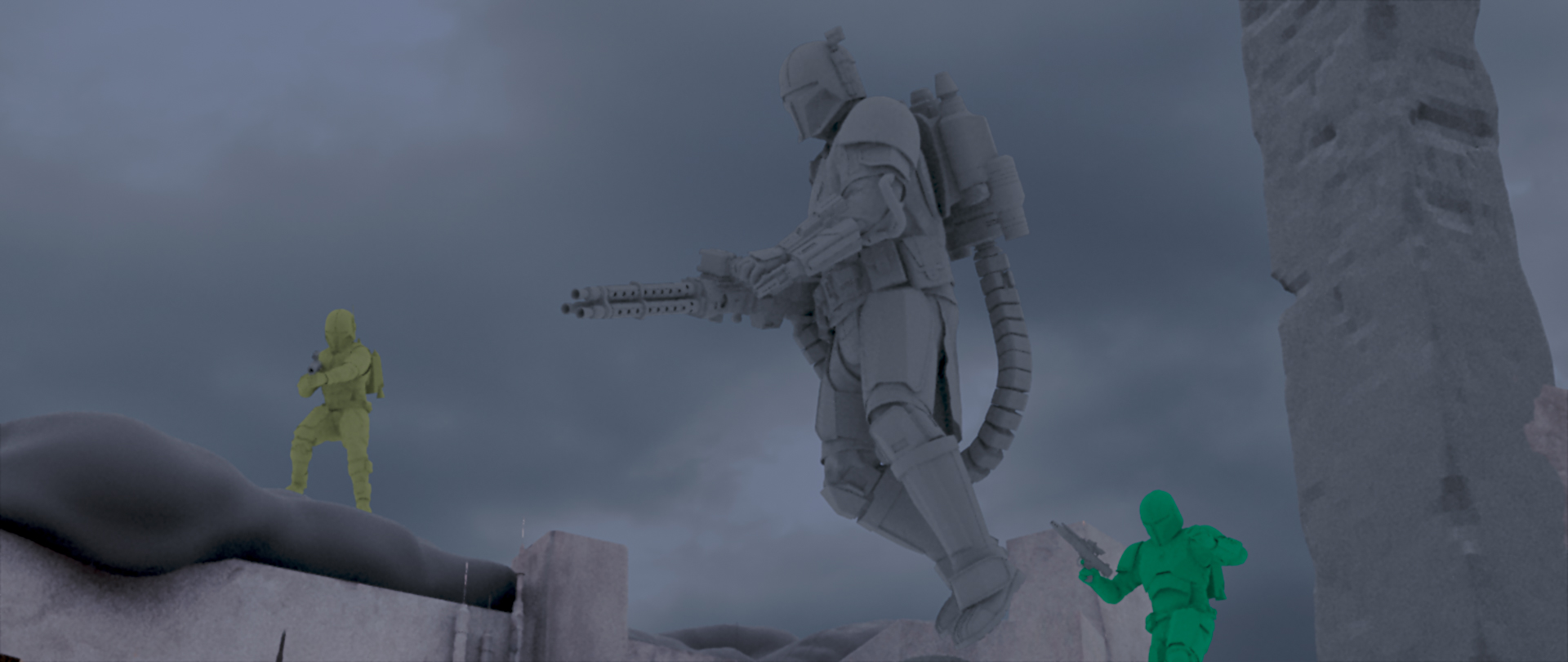
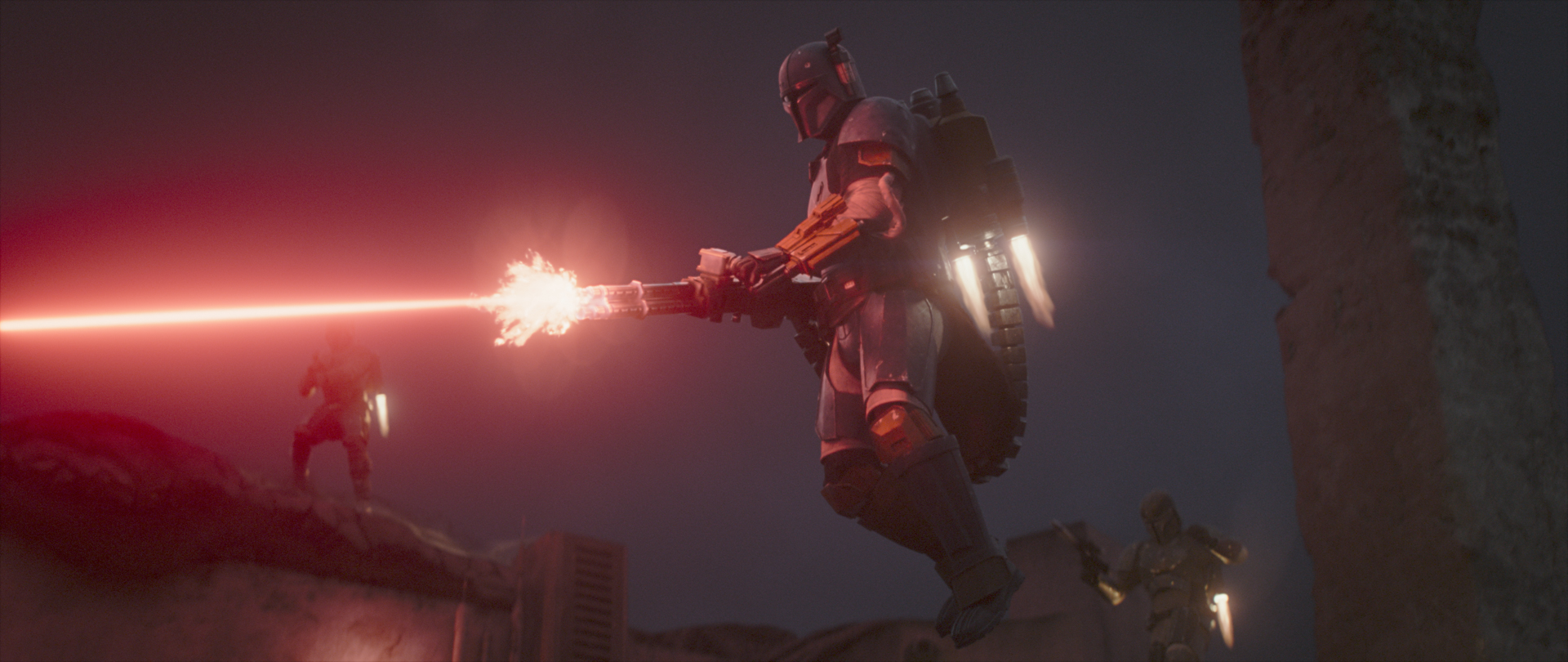
When it came to animation, Image Engine ensured its efforts felt real alongside the on-set footage of practical actors on rigs. “The Mandalorians are flying around in jetpacks, so we made sure we mimicked the look and feel of the on-set actors in our digital assets,” says Hackl. “We also used some internal motion capture to get that physical feel in our work, such as capture of our animators jumping from a chair onto the floor to represent a landing Mandalorian. That way, everything felt real and unified.”
Pew pew pew
One classic Star Wars feature certainly not lacking in the Nevarro sequence is its famous laser blasts. The heavy Mandalorian carries a Vulcan cannon-esque Gatling gun that spits our volleys of ruby-hued projectiles, and a final conflict with Greef sees the screen crisscrossed with lances of scarlet.
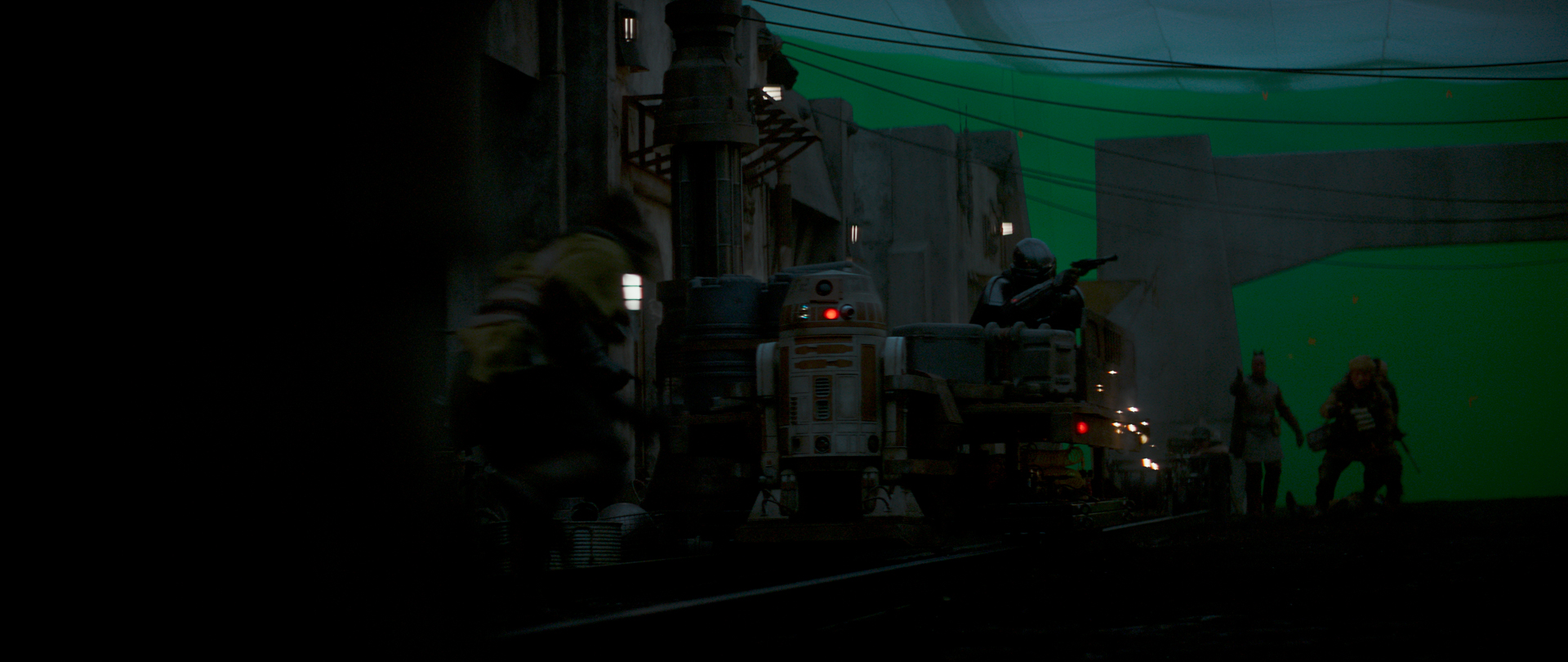

“You could watch Star Wars a million times and still be unprepared for just how much work goes into a seemingly simple blaster effect,” says Hackl. “For starters: portraying their speed. You need to see a blast for a certain amount of frames to understand its directionality, but if it’s on frame too long, it reads as slow. It takes work to get them to register properly.”
And then there was the task of integrating them into the world. To do so, Image Engine took advantage of the fully digital Nevarro set it had built for matchmaking purposes. “We could animate each blaster bolt in 3D space, then use the bolt to light the surrounding environment using mesh lights – along with some heavy grading for practical props. That made the lasers feel much more a part of the world – and much more threatening.”
100% mechanically accurate
For episode six, Image Engine launched from terra firma to a spacecraft nestled among the stars. Here, the Mandalorian and a crew of misfits come up against a squad of security droids, which the bounty hunter soon dispatches in a single-handed show of prowess.
“When we saw the previs, we knew we had to get this sequence,” says Davies. “Considering our history in animating droids, it felt like the perfect fit.”
The studio got its wish. Not only did Image Engine get to create (and destroy) an MSE-6 “Mouse Droid”, but it also engineered the seven complex, articulated security droids that attempt to put an end to the Mandalorian.
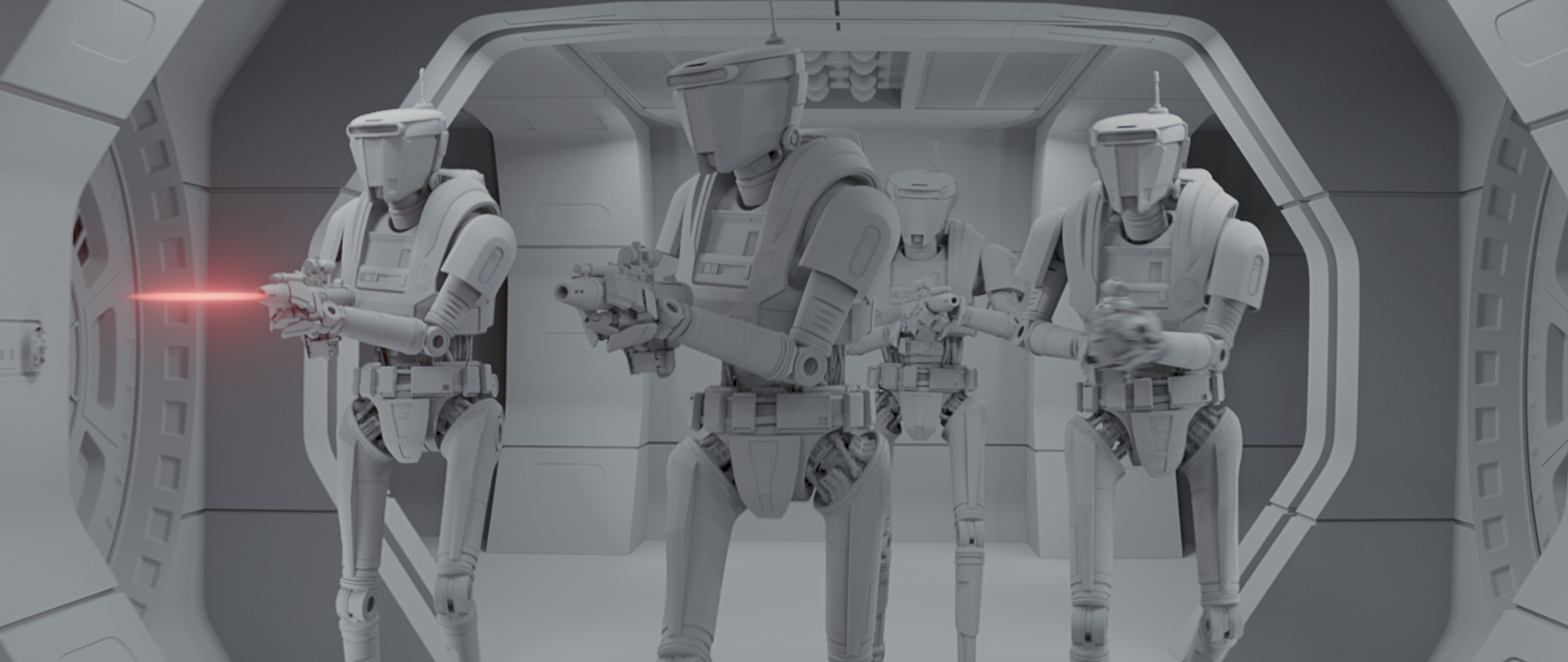
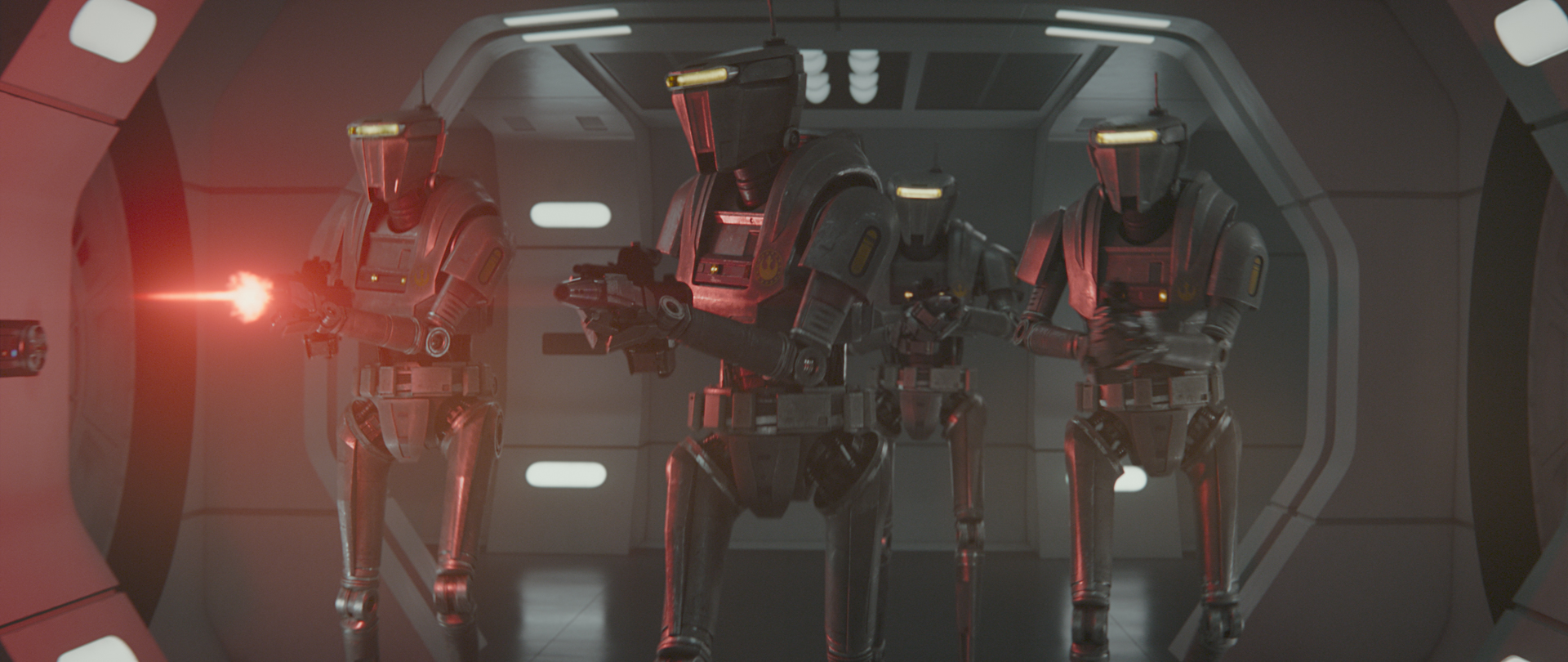
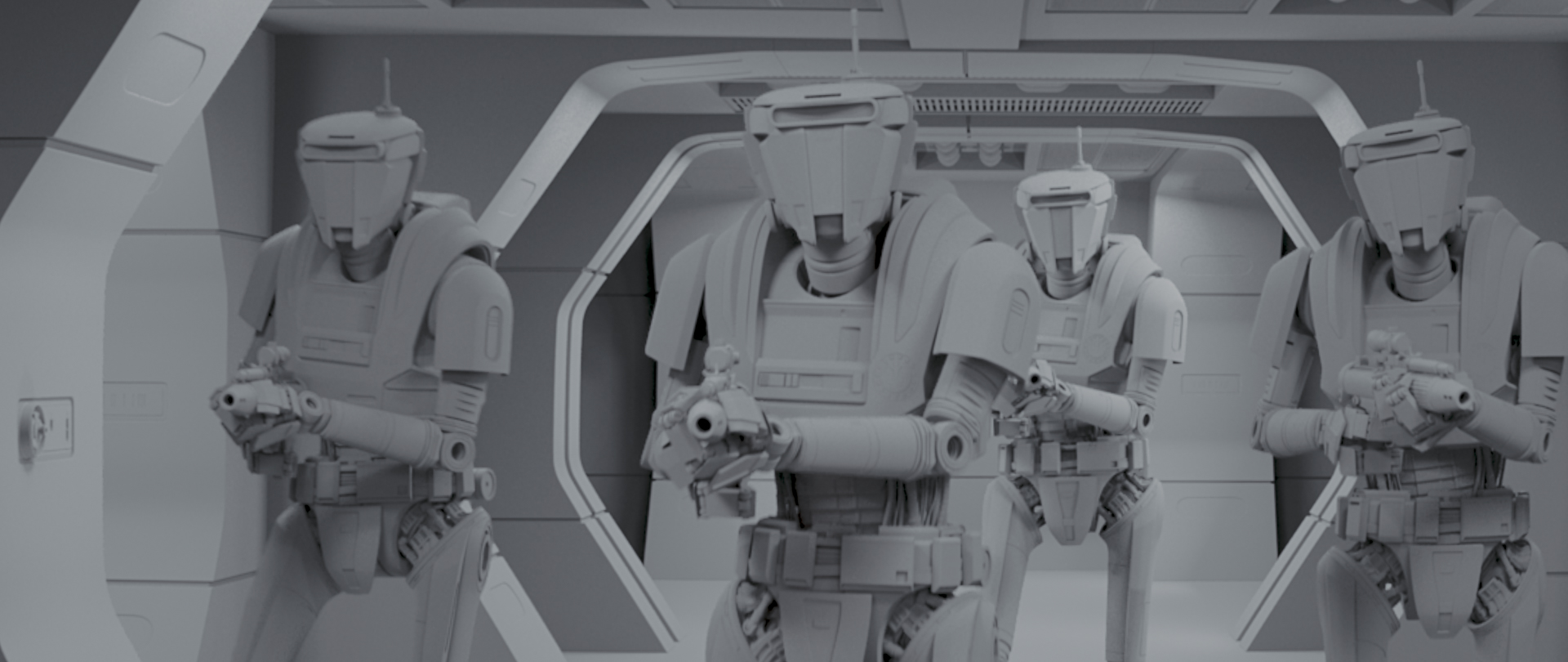
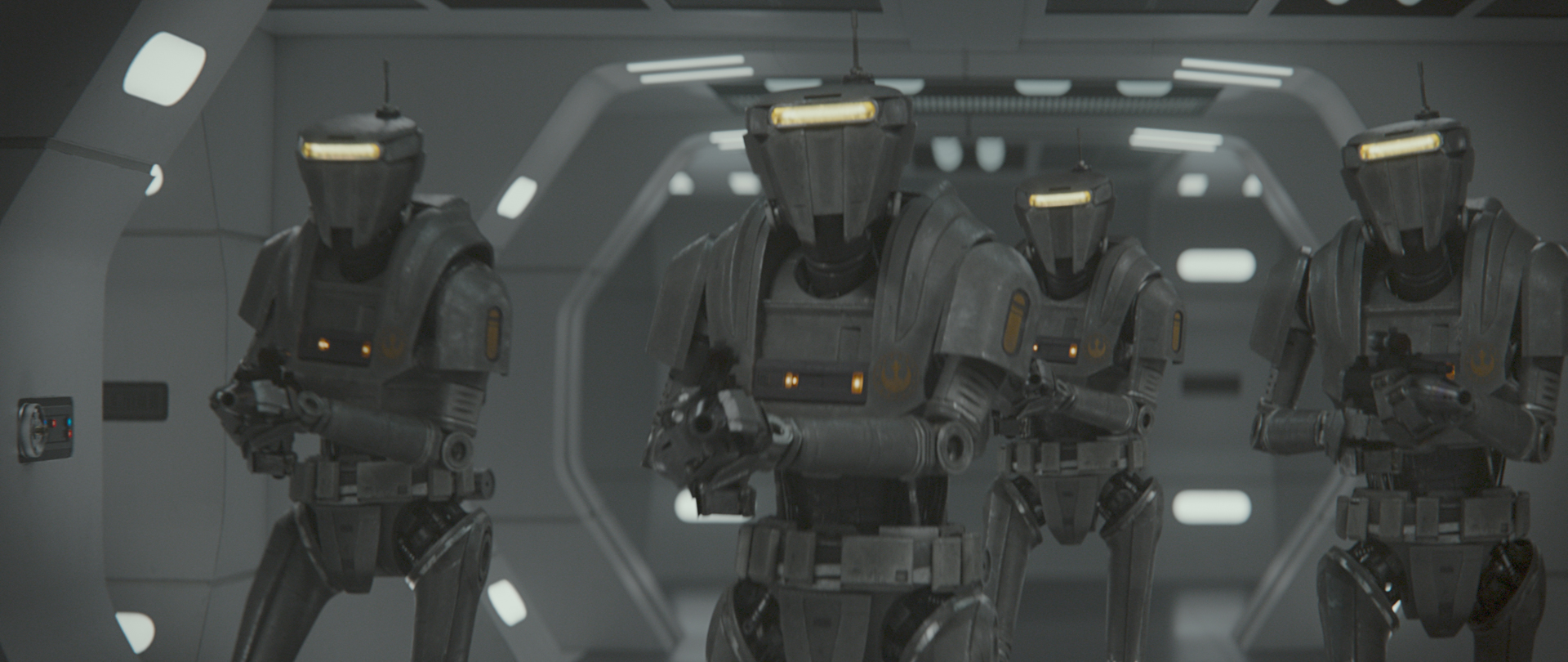
“They were a significant build for the assets team,” says Poon. “We received the concept model, blocked out a design and performed a lot of back and forth with ILM and legends like Doug Chiang (VP and Executive Creative Director of Lucasfilm) to get the look just right.”
Part of the challenge was in making the robots mechanically accurate. But of course, this was one challenge with which Image Engine has some experience. “The droid animation was based on motion capture, so the rig needed to cover the full range of human movement while also working within the constraints of mechanical joints,” says Poon. “We didn’t want to cheat with ball joints, as that can cheapen the design. There was a lot of testing between assets, rigging and animation to get this just right. Thankfully, our prior experience helped move things at a fast clip.”
The lookdev and texture teams also had their work cut out on the droids. They created several damage states (the robots are stabbed, decapitated, amputated and burned) while also adding a considerable amount of detail for the up-close shots. “The resolution had to hold up against all different lighting conditions and shots,” says Poon. “That includes everything down to the wear and scratches we added around the droids’ hands. There was tremendous detail in there.”

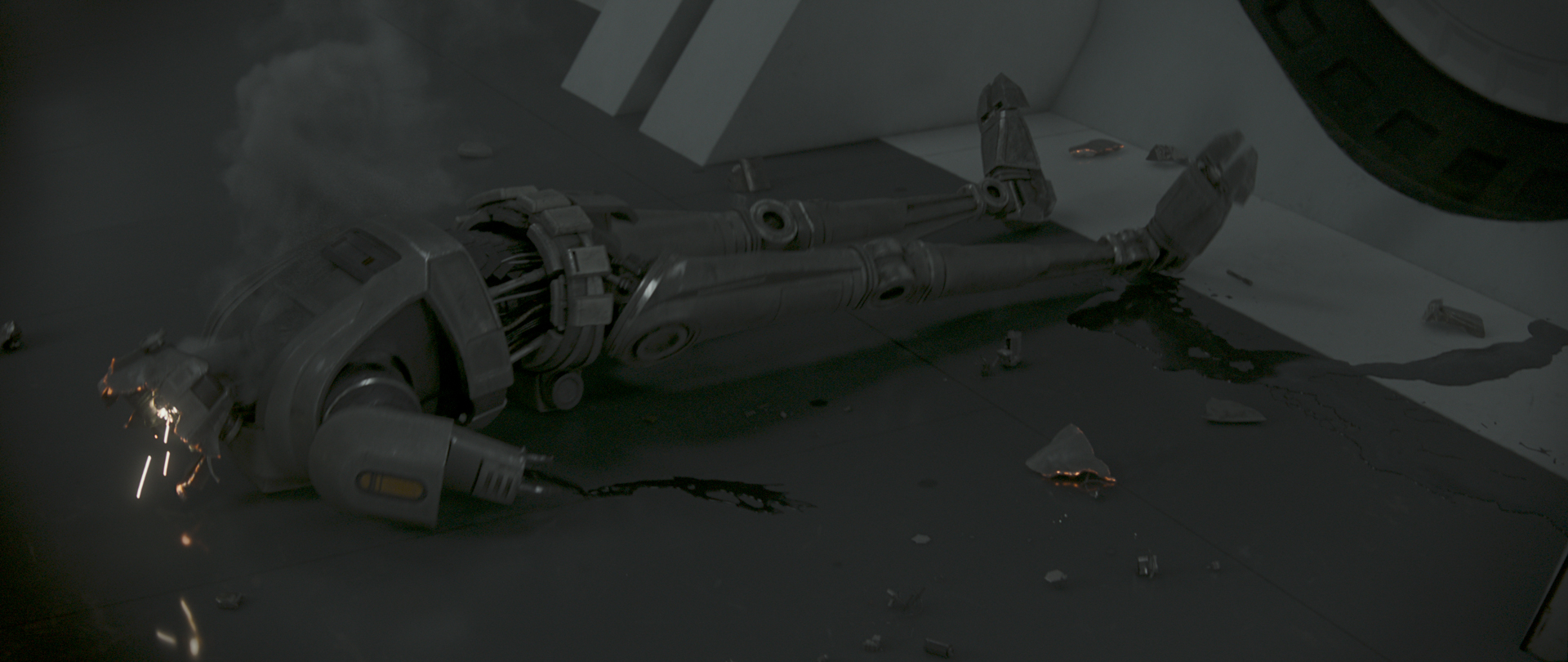
Making moves
On-set motion capture, performed by a stunt crew, drove much of the droid animation. This in combination with in-house motion capture and keyframe animation made up the 7 digital droids seen throughout the sequence. “The motion capture maintained the physicality of the Mandalorian throwing, smashing and ripping heads off – our keyframe animation needed to keep pace with that,” says Davies.
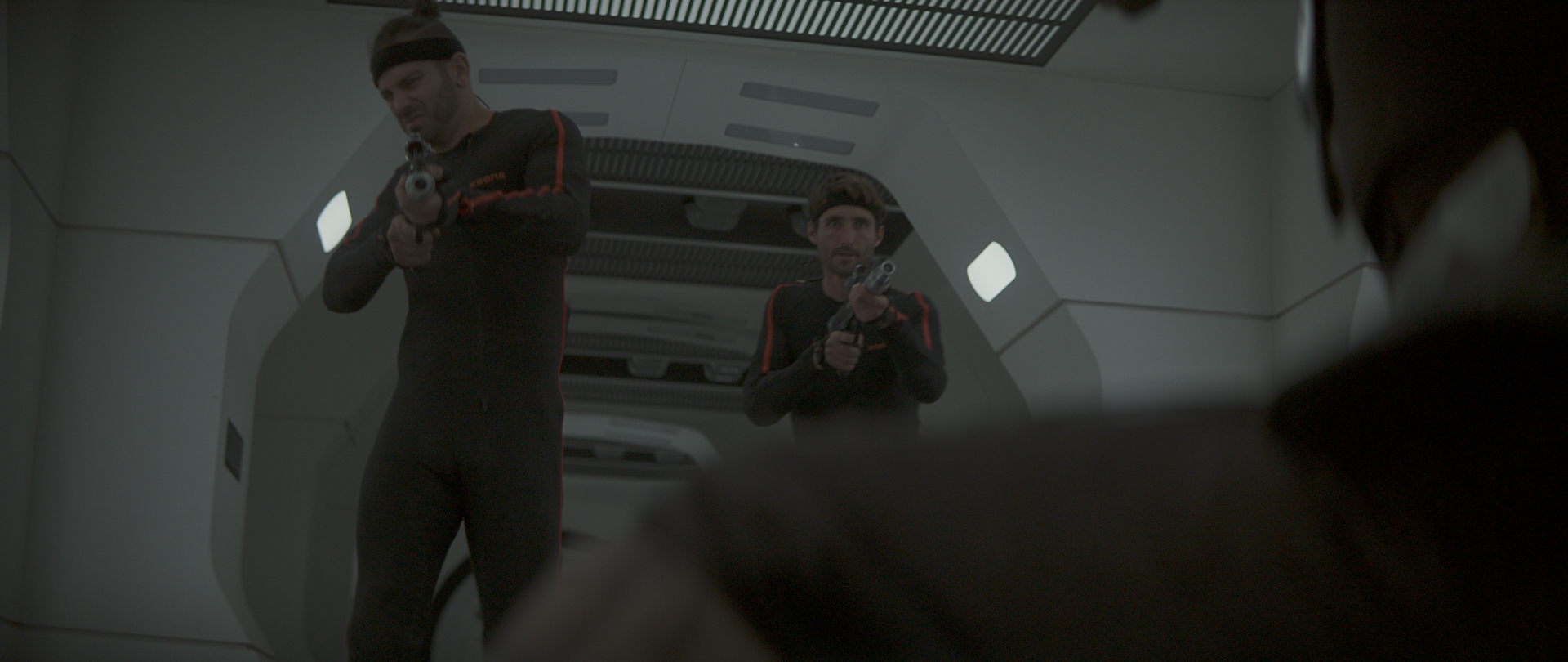

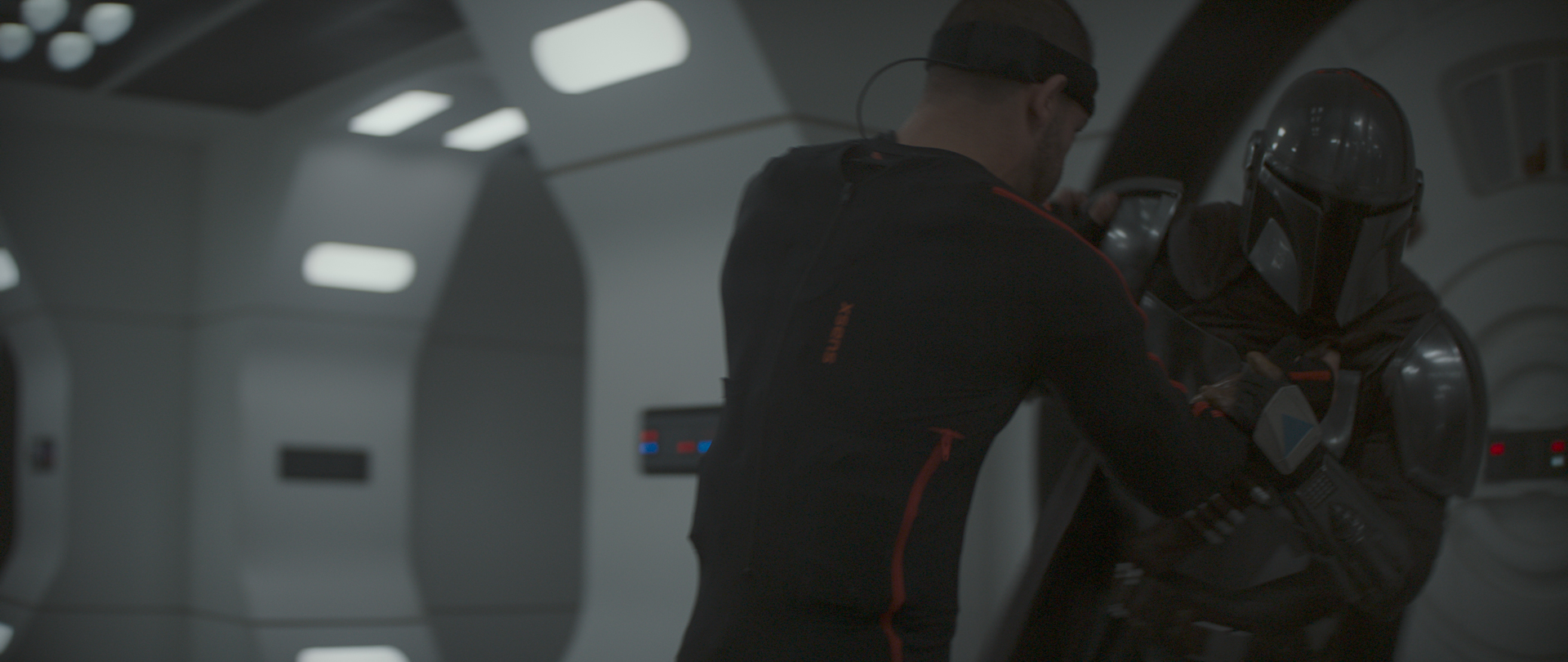

The real challenge came in clean-up and removing the motion capture actors from the shots in which they appeared. “That was tricky, as there’s a lot of physical interaction between the Mandalorian and the stunt team,” says Hackl. “The best way to approach this was to replicate the physical set 100% digitally, which would make it much easier to paint out the stunt crew. We did so without using any photography or scans – it was all CG. There were some dailies where even I wasn’t sure if I was looking at the plate or our digital work!”
A blast from the past
Episode eight saw Image Engine once again build out a backdrop of violence; this time witnessed through the lens of memory.
The episode takes audiences back to the Mandalorian’s origins, revealing his liberation from the war-torn milieu of Aq Vetina. Image Engine’s shot sees The Mandalorian lifted from the battlefield by a jetpack-wearing saviour, the camera panning out to reveal chaos and destruction as Mandalorians clash with deadly battle droids below.
“It all takes place across four seconds, but it’s filled with an immense amount of detail,” says Hackl. “The shot required a ton of FX work, explosions, squibs going off, droids getting killed and Mandalorians swooping from one rooftop to another. There’s a lot to take in.”
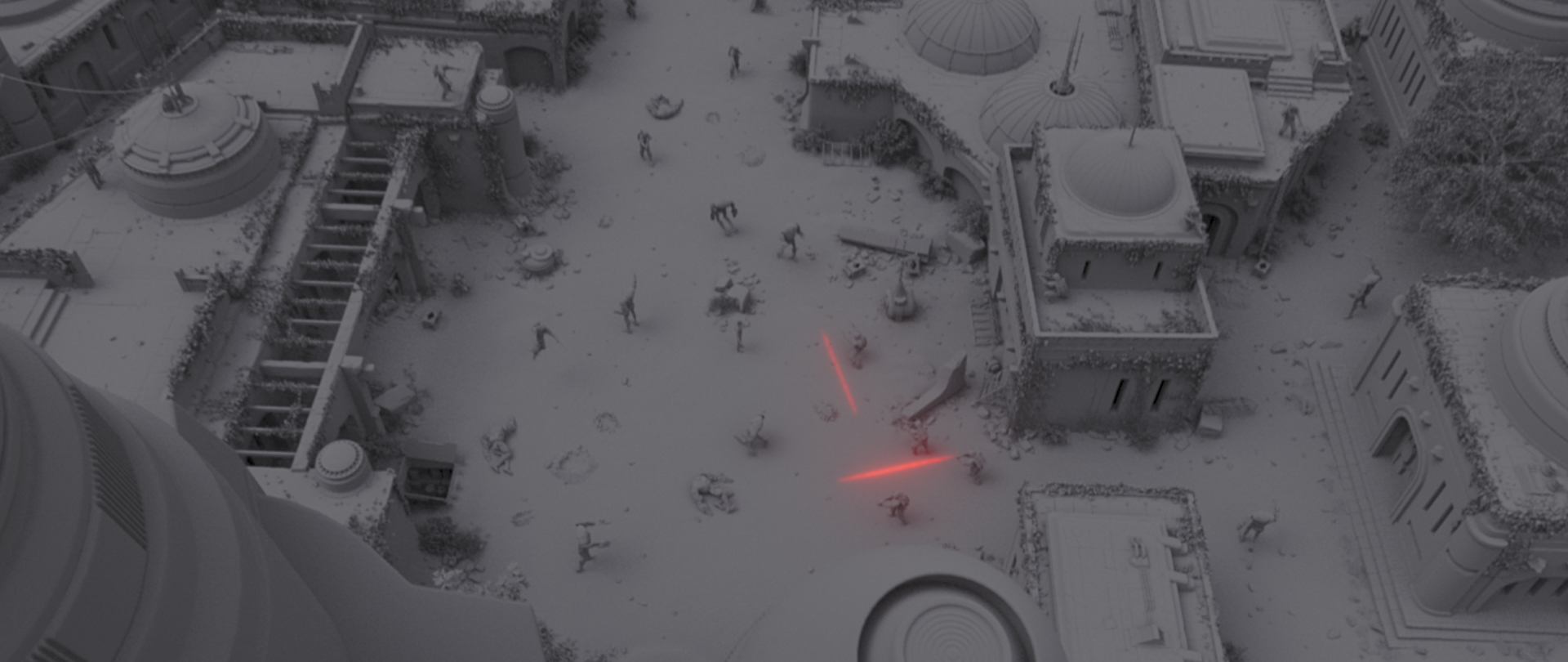
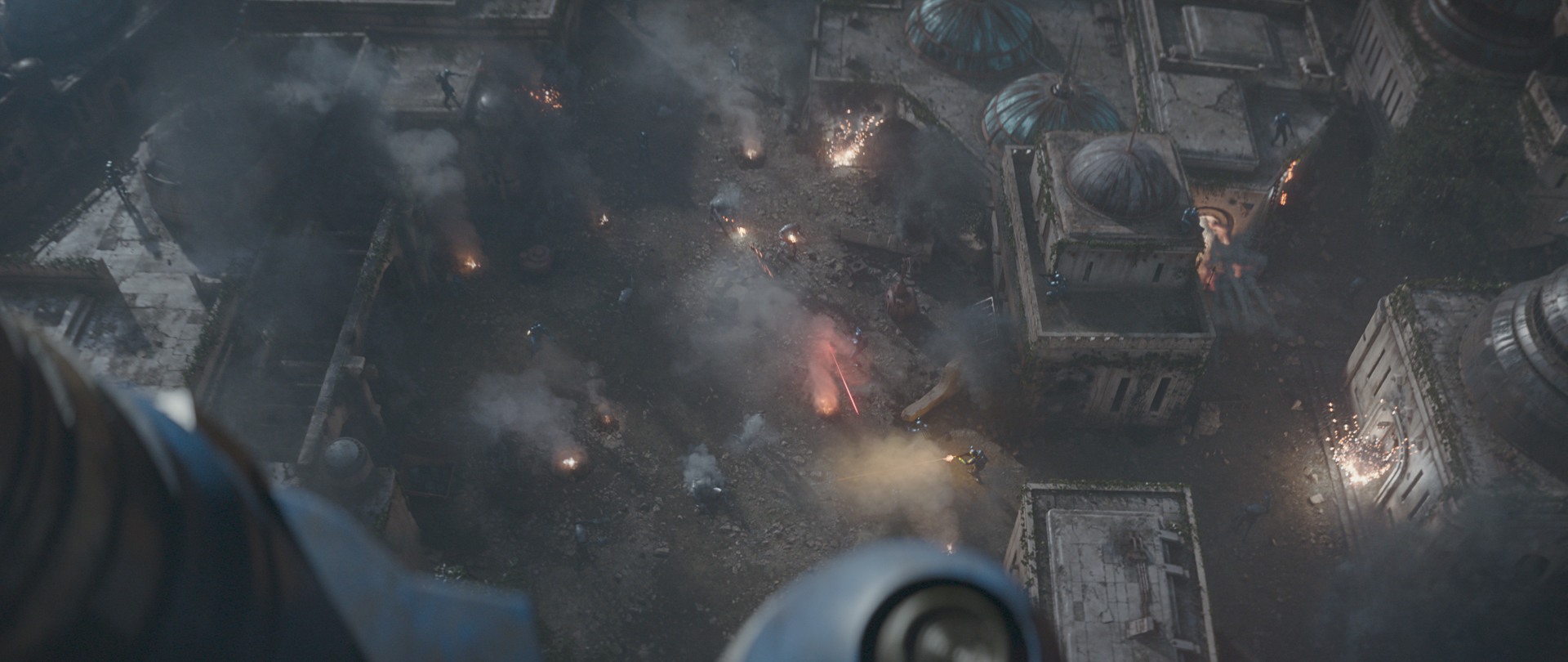
In building the city asset – which was entirely 3D, with no digital matte paintings involved – Image Engine matched the aerial aesthetic of the city to the previously witnessed ground-level action. “We wanted to make sure that it felt like the same place seen from above as from within,” says CG Supervisor Raphael Gaudin.
“We used a lot of reference material from European, Mediterranean and African cities with classical architecture. We then spent a lot of time in layout, making sure that no two areas of this cityscape felt repeated. We went way wider than what the shot required in our build, but that helps create a more natural look. You get a sense that you’re not seeing the whole city as it is, but just a smaller section cut from a larger urban sprawl.”
From there, it was a case of adding in the destruction and FX that bring the shot to life – as well as a few Easter eggs: “There’s a hot dog cart-pushing droid in there, but the shot cuts just before he makes it into the frame!”
Utinni!
Image Engine’s final episode takes place upon the mud planet of Arvala. The team created several establishing shots that document the Mandlorian’s approach to a rain-drenched Jawa camp (including work on a Sandcrawler asset ingested from ILM) and enhanced several more as he bargains with the camp’s tight-fisted inhabitants.
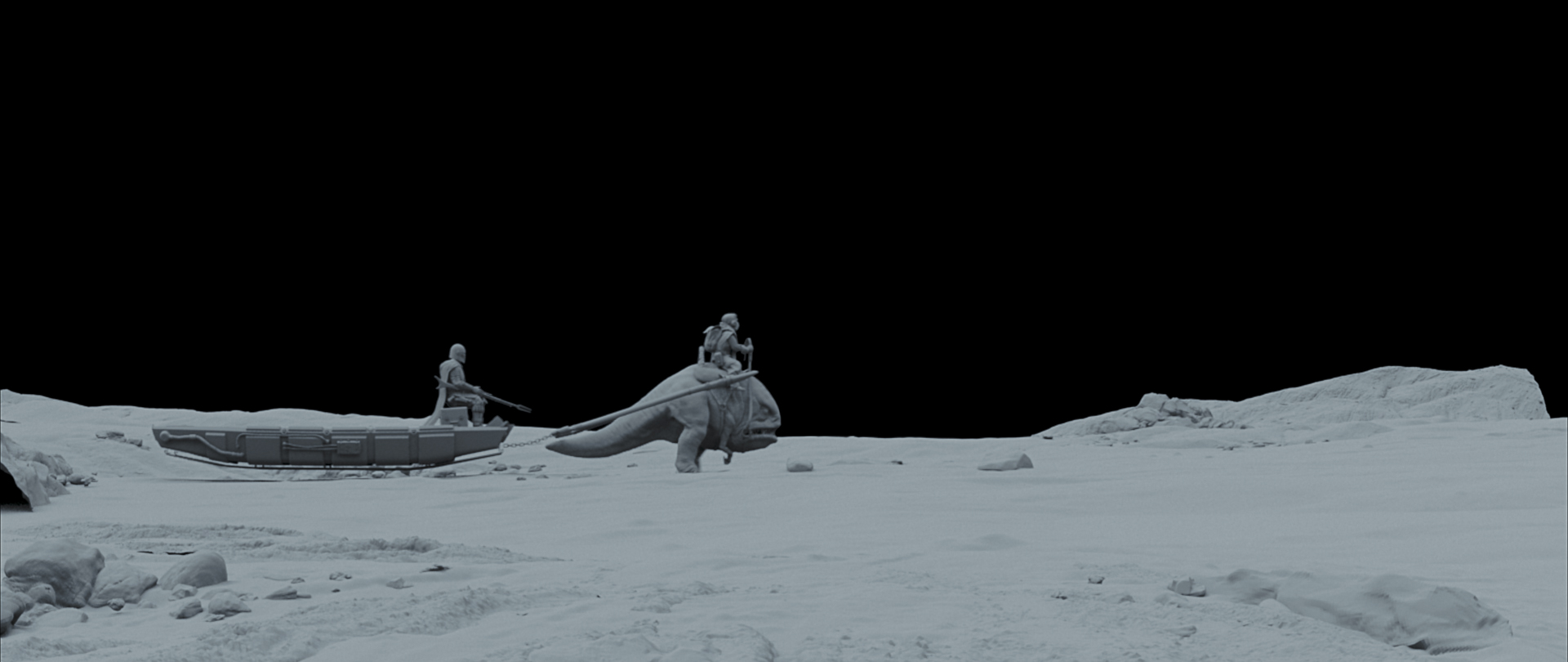
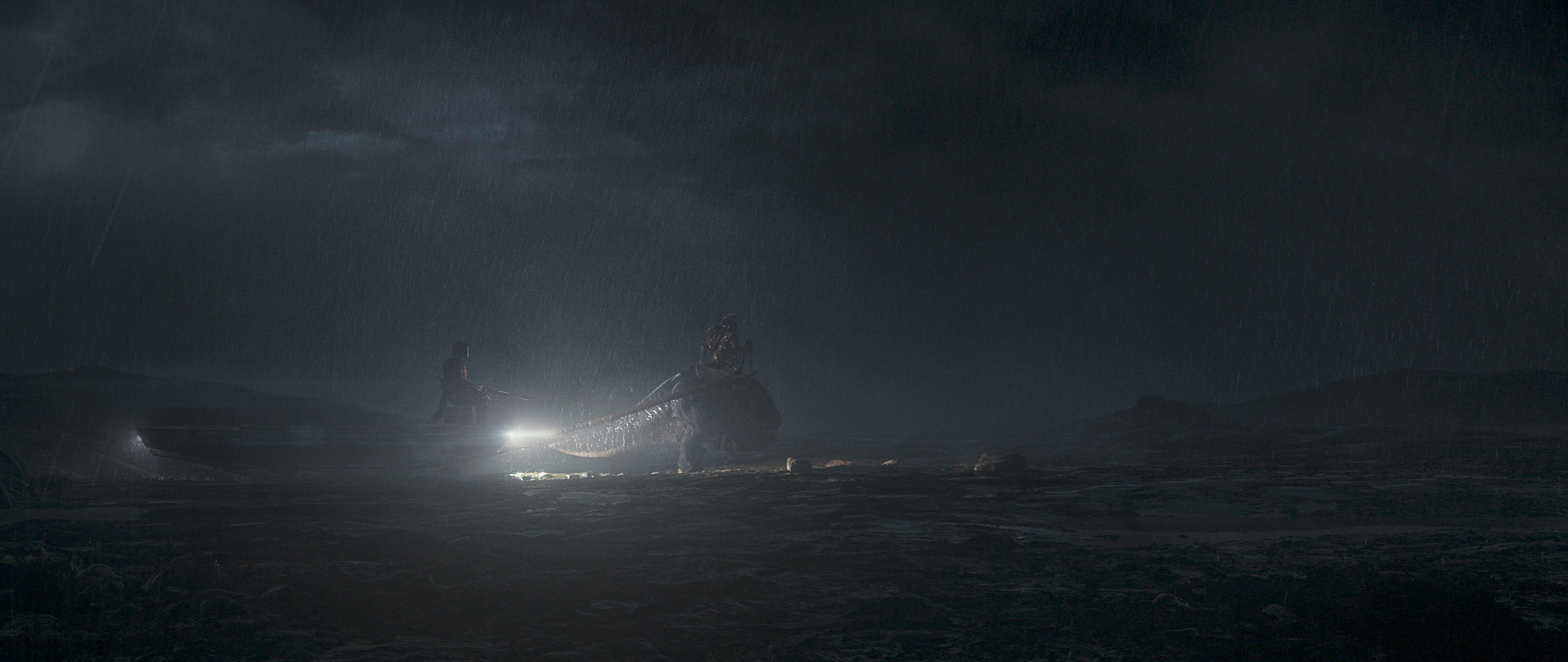
Some of these shots required fixes of the Jawas themselves, such as repositioning their glowing eyes and ensuring the centre of their faces receded into complete blackness. “There was a lot of light coming from their LED eyes,” says Hackl. “We removed any light reflected off the inside of the hoods, or from objects that the actors were holding.”
It was also on Arvala that Image Engine touched upon some of the more innovative elements of The Mandalorian’s real-time storytelling tech. The Mandalorian is one of the first live-action productions to make use of 360-degree LED display monitors, which display interactive backdrop assets rendered in real-time. These volumes give actors a better sense of place in which to root their performance than that provided by a green screen. Furthermore, the volume’s LEDs radiate real light and reflections as if from a non-digital location.
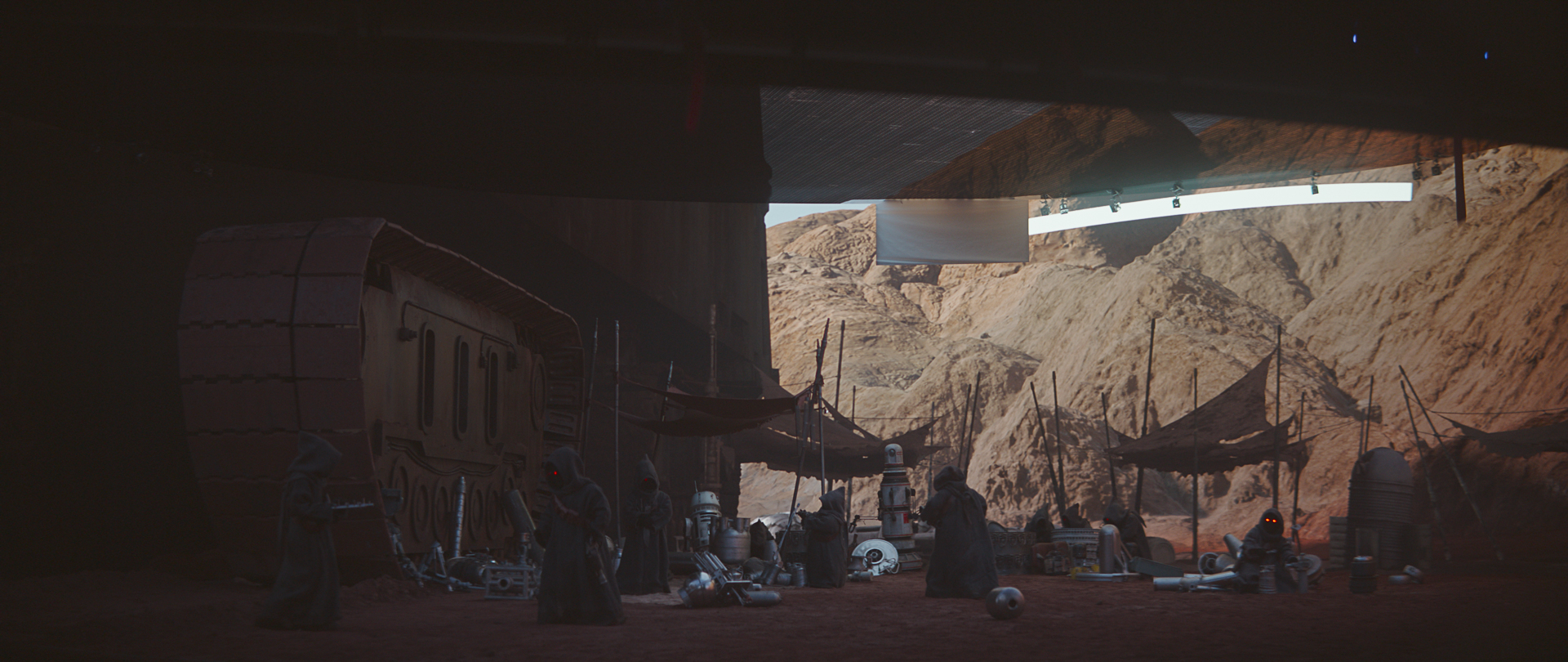
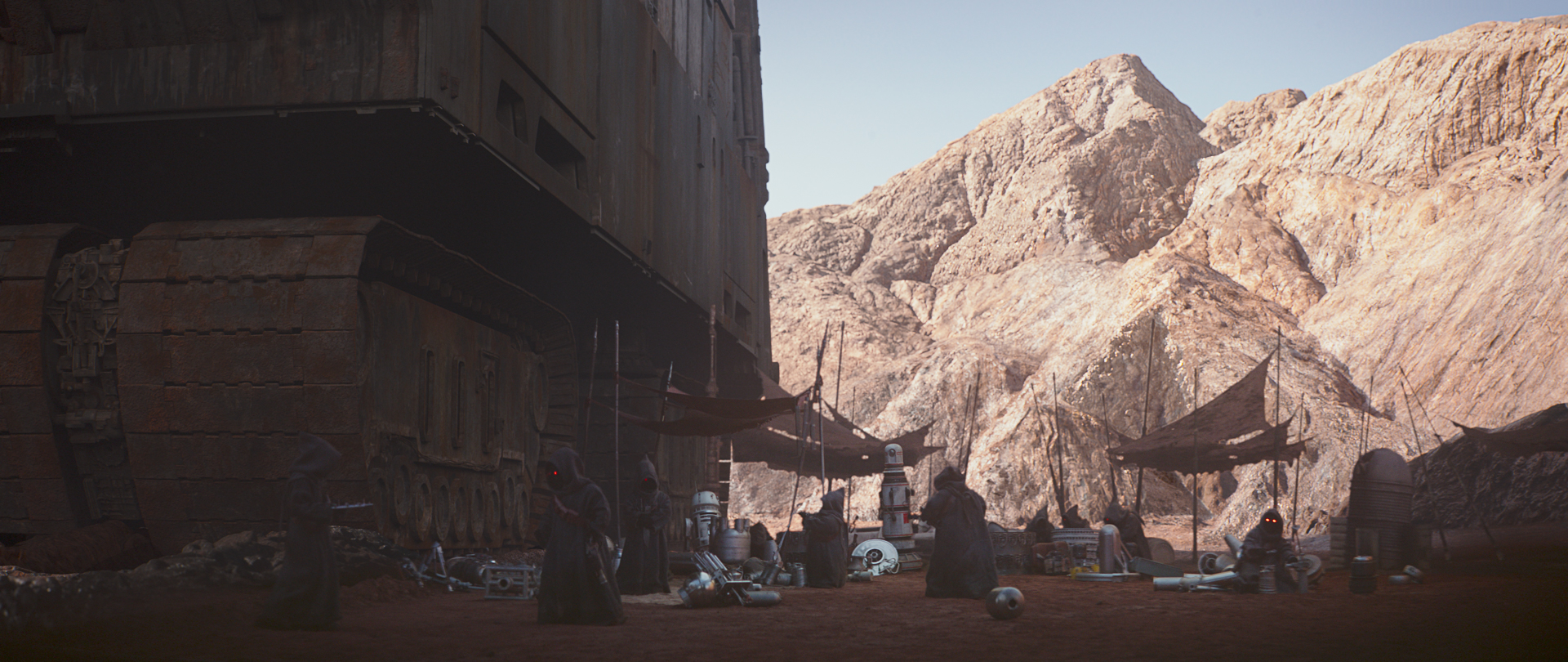
“It was a very sophisticated setup,” says Hackl. “Nevertheless, in some cases, due to the nature of the shot, we needed to tweak that display. For instance, in one shot, the LED volume didn’t provide enough light to simulate real daylight. We performed heavy grading work on the on-set props to make them feel more a part of that real-time backdrop.”
In the instances were the real-time background felt out of place, Image Engine entirely replaced the LED volume with an elaborate CG backdrop. To do so, Image Engine ingested the real-time assets used to create the volume from ILM, uprezzed them in lookdev and texture, ensured the cameras lined up correctly, then turned the asset over to the environments department.
“Integrating those backdrops into the plate photography was complex,” says Edmond Engelbrecht, CG Supervisor. “There are many physical differences to consider between tracking a practical shot and tracking projected content, like the colour space and the real light you get from on-set cameras sensors.
“Considering that the work was turned over to us quite late in the schedule, we had to think fast,” he says. “The final results are a testament to what the team can do with little time and a lot of ingenuity.”
A long time ago…
Image Engine has worked within some fascinating universes. It’s built Stark tech for the MCU, tamed dragons in Westeros and conjured up creatures for J.K. Rowling’s Wizarding World. Now the studio can add droids and bounty hunters from a galaxy from far, far away to its list.
“It’s been super exciting – working in the world of Star Wars has been a long-term goal for a lot of the Image Engine crew,” says Robin Hackl. “It was especially exciting to work so closely with ILM and industry icons like Doug Chiang. They made The Mandalorian such an incredibly enjoyable experience. They offered us so much freedom to explore and find solutions. And what’s more, they were so complimentary of the work – and ILM holds a pretty high bar!
“Considering all of that, the Mandalorian was a massive accomplishment in my eyes,” he concludes. “From landing work in the Star Wars universe in the first place to the quality of the content we produced; the Force was strong with this one.”


